What To Wear Mountain Biking
Wondering what to wear mountain biking? Learn everything you need to know about mountain bike-specific clothing, apparel, and more.
When I first started mountain biking, I did not ‘look’ like a mountain biker. I wore soccer shorts, ankle socks, and tennis shoes. But did that stop me from having fun? Absolutely not. If that’s where you’re at – awesome.
This gym-style wardrobe worked for a bit, but after hitting some rowdy (to me at the time) trails, I quickly realized I needed a serious upgrade for comfort and protection out on the trails.
Over the years, I’ve definitely honed my mountain biking wardrobe and it continues to evolve as I discover new brands and as my preferences change.
In this post, I’ll help you explore the essential gear that will not only keep you comfortable and protected but also have you looking like a true trail-blazing fashion icon.
From head to toe, I’ll dive into helmets, jerseys, shorts, gloves, and shoes, discussing the features that make them ideal for any mountain bike adventure.
So, if you’re ready to up your style game, you’ve come to the right place. Get ready to transform your mountain biking wardrobe and be the envy of all your fellow riders.
Let’s gear up!
Safety First: Helmets and Protective Gear
When it comes to mountain biking, safety should always be the top priority, and that’s where helmets and protective gear come into play.
A high-quality helmet is a non-negotiable item for any rider, providing essential head protection in case of falls or accidents. Look for helmets that meet safety standards and consider the type that suits your riding style, whether it’s a full-face helmet for downhill days or a lightweight half-shell for all-mountain adventures.
Additionally, don’t forget about the importance of protective gear such as knee pads, elbow pads, and gloves. These not only provide impact protection but also enhance your overall riding confidence by reducing the risk of injuries.
Below are a few of my favorite pieces of mountain bike protective gear.
Helmet
A helmet is the most vital piece when it comes to what to wear mountain biking. Promise me that you will never ride without a helmet, mkay? You may already own a helmet, but if it’s old, cracked, or dented it’s definitely time for a new one. The material can break down over time and helmet technology has advanced significantly over the past decade.
The current MIPS technology (Multi-directional Impact Protection System) is designed as a slip-panel system that reduces rotational forces during impact. If you’re buying a new helmet, make sure it has a little MIPS sticker on it or is certified in some other way.
My favorite mountain bike helmet is the Giro Manifest. It’s a bit pricey, but it’s the most comfortable helmet I’ve ever worn and it has great ventilation (and I sweat a lot). It can be adjusted with a dial in the back to get the perfect and most comfortable fit and it’s MIPS certified.
There are lots of options when it comes to choosing a great helmet, so take your time doing research to find one that you actually enjoy wearing.
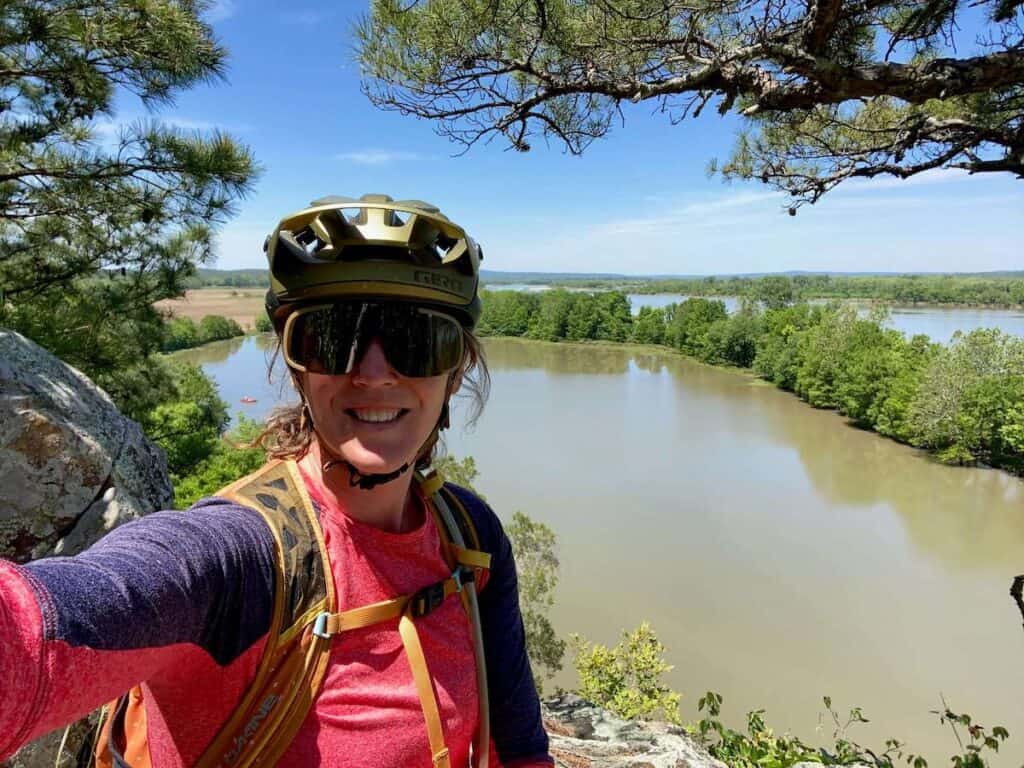
Knee pads
I almost never ride my mountain bike without wearing knee pads. I’ve had my brother (an ER Doctor) stitch me up too many times to risk it. Knee pads can be tricky, though, because oftentimes they slip down while you’re pedaling or they’re just so darn uncomfortable that you don’t even want to wear them in the first place.
So you better believe that I was super excited to find the Fox Enduro Sleeves because they stay right where they’re supposed to and they’re long enough so they don’t leave a gaper gap between your shorts (major mtb faux pax).
The only downside to these pads is that the back mesh tends to tear easily, leaving big holes behind your knees.
If you’re planning on doing more high-stakes mountain biking and want some extra protection, I also have the Fox Launch Pro knee pads, which I use for the bike park.
Sunglasses
Sunglasses may not seem like a piece of protective gear, but they actually are. A good pair of shades will protect your eyes from flying dirt and debris as well as from wayward trailside branches. Oh, and they also do a pretty good job of protecting your beautiful eyes from the sun.
My favorite pair of mountain biking sunglasses are the Smith Shift Mag. These sunglasses are designed with a magnetic clip that makes it super easy to swap out lenses based on conditions.
Don’t want to swap lenses? Get the light-sensitive Photochromatic option that actually adapts to changing light conditions. Magic!
Read More
Mountain Bike Protection
Keeping Cool & Comfortable: Mountain Biking Jerseys
Mountain bike jerseys are more than just a simple shirt; they play a crucial role in enhancing your riding experience. Designed with breathability and moisture-wicking properties, these jerseys keep you cool and dry during intense rides by effectively wicking away sweat.
They often feature lightweight and durable materials that can withstand the rigors of the trails. Depending on your preference and the weather conditions, you can choose from short-sleeve or long-sleeve jerseys.
Additionally, trail-specific jerseys may come with extra features like zippered pockets for storing essentials or a built-in lens wipe for your goggles or glasses.
3/4 sleeve & short sleeve jerseys
I love, love, love my Kaden Apparel Gryla mountain bike jersey. It’s made with super soft material (like really soft), and the cut is very flattering. It’s just perfect in all the ways.
This is my go-to jersey for cross-country or all-mountain rides. If you prefer a short-sleeve, the Florence Jersey is made from the same material.
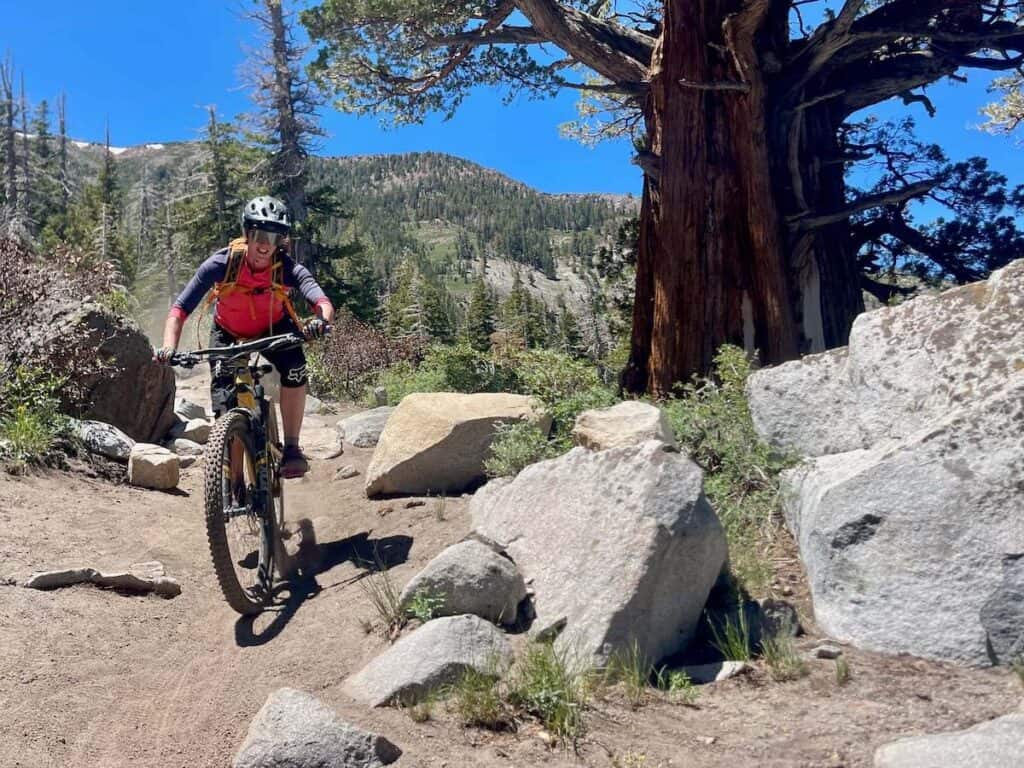
Long-sleeve jersey
When I want to wear a long-sleeve jersey (whether it’s because the temps are cooler or I’m at a bike park where I want more protection), I grab my Troy Lee Designs Lillium.
This jersey has a nice loose fit without looking boxy or feeling bulky. I also love that it has little perforated holes throughout the material for airflow and ventilation.
Plus, it comes in awesome patterns and color choices! The Lillium does come in a short-sleeve option, but I haven’t tried it.
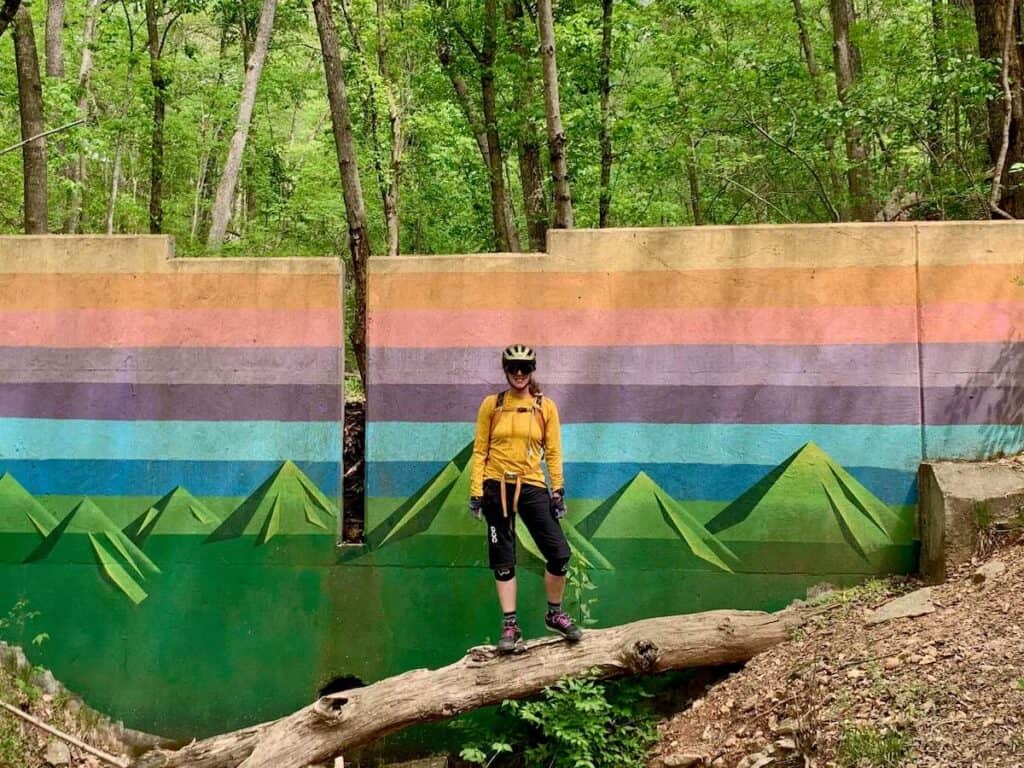
Freedom of Movement: Shorts & Pants
Mountain bike bottoms include baggy shorts, chamois (aka padded liners), and pants.
There are two different camps that mountain bikers fall into: those that wear ‘baggy’ shorts over their spandex liners and those that only wear spandex liners.
Typically, the ‘baggy shorts’ people are more downhill, gravity, and enduro-focused while the ‘spandex’ people like to pedal uphill.
You’ll discover pretty quickly which crowd you like to hang out with on the trail.
In colder weather or for added protection, mountain biking pants are also a great option. They offer insulation, wind resistance, and sometimes water resistance, allowing you to ride comfortably in various conditions.
Chamois
Padded liners, chamois, or shammies, whatever you call them, they are important when deciding what to wear mountain biking.
These are perhaps the most important piece of mountain bike clothes you can wear aside from a helmet! You gotta keep your tush and nether regions comfortable and cool, right?
As I mentioned above, some mountain bikers prefer to only ride in liners while others (like me) wear padded liners underneath baggy mountain bike shorts. Either way, these liners help keep your rear end from getting sore and can help prevent the dreaded chafing.
My favorite pair of padded liners are the Terry Prima Bella Shorts. They’re very comfortable and fit like a glove, which is what you want for liners.
Baggy mountain bike shorts
My all-time favorite mountain bike shorts are the POC Essential Mountain Bike Shorts. I’m on the taller side for women (5’8) and a lot of shorts don’t cover my knee pads or fit my wider hips.
The POC shorts fit me so well and are flattering and still have all the other important features like stretchiness, pockets (that fit a phone), and adjustable velcro waist tabs. They’re made from quick-drying nylon fabric that is lightweight yet durable.
Read next: Want to know more? Here’s my full POC Women’s Essential MTB Shorts review.
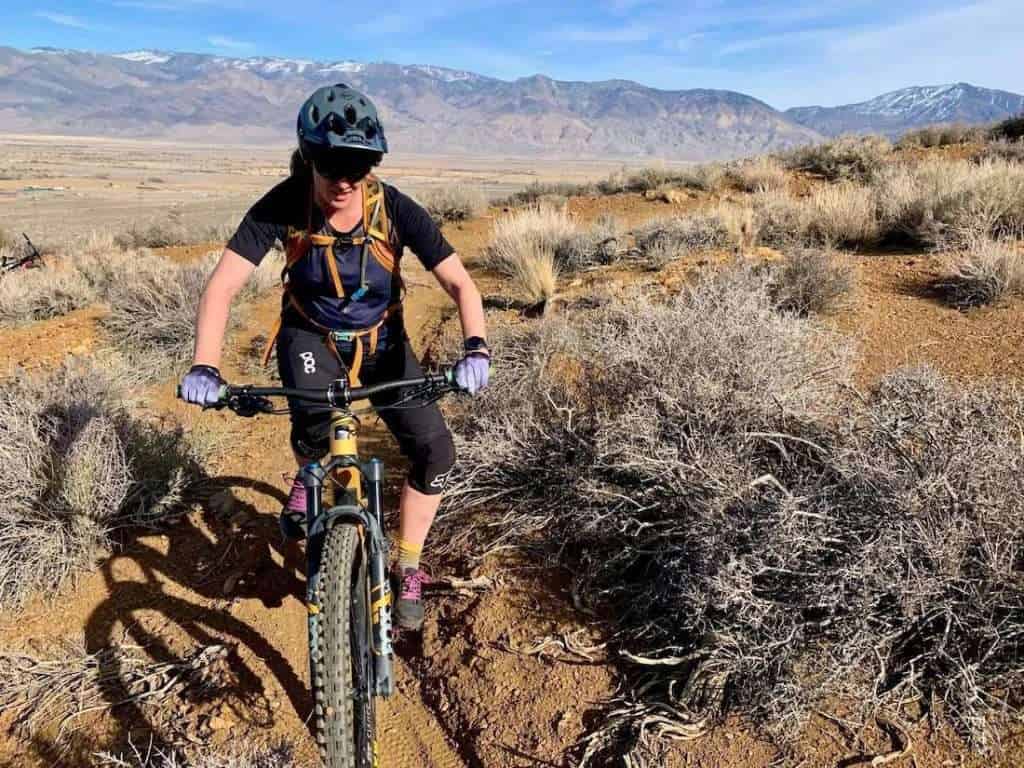
Mountain bike pants
I only recently started wearing mountain bike pants for colder rides and at the bike park and I’m a convert! I love the added warmth (obviously) and the added protection for more rowdy riding.
The Revel Rider Flow Pant has quickly become a favorite. I love the lightweight, yet durable and stretchy material and the contoured fit that allows for movement.
Plus, Revel Rider is a small women-owned business and I love supporting that.
Read More
Women’s Mountain Bike Apparel
Grip and Control: Gloves & Footwear
When it comes to mountain biking, having a firm grip and maintaining control over your bike is paramount. That’s where gloves and footwear play a crucial role in staying safe and having fun.
Mountain biking gloves provide several benefits, including improved grip, shock absorption, and protection for your hands. Look for gloves with durable materials and features like reinforced palms and knuckle protection. They should fit snugly but still allow for dexterity and breathability.
When it comes to footwear, choosing the right shoes can make a world of difference. For flat pedal riders, opt for shoes with sticky rubber soles that provide excellent traction on the pedals.
If you prefer clipless pedals, consider mountain biking shoes that offer a secure connection with the pedals and have a stiff sole for efficient power transfer.
If you’re not sure which platform to choose, I recommend starting with flats. You can read more about flats vs clipless in this post.
Mountain bike gloves
There is a range of mountain bike-specific gloves out there from basic and simple gloves to ones that have padded protection in case you become friendly with a tree.
If you’re just starting out, a simple glove will do. I really love the HandUp Most Day Gloves because they have super fun designs and sayings across the palms.
I’ve also found that HandUp gloves last a lot longer than most other mountain bike gloves that I’ve tried. I biked 630 miles across the state of Washington with one pair of HandUp gloves and they didn’t get one hole or rip.
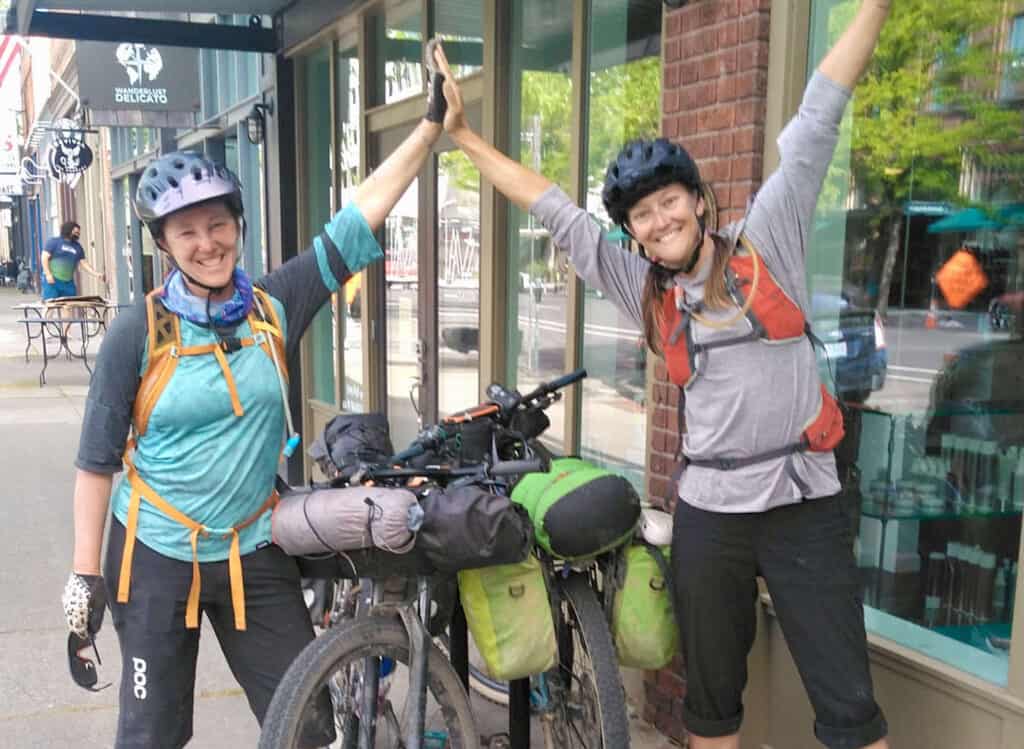
Mountain bike shoes
I ride flats and my favorite shoes are the Ride Concepts Livewires.
The soles are super grippy so my feet don’t slide off the pedals and I find them to be really comfortable as well.
They also dry fast and last more than one season, unlike some other brands (ahem, Five Tens) and pairs that I’ve tried.
If you ride clipless, check out the Ride Concepts Hellion Clip.
Read next: Read my full Ride Concepts Livewire review
Mountain bike socks
Typically, mountain bikers wear taller socks to help prevent our shins from getting shredded by trailside brush. A low-calf or mid-calf sock is great.
I love Darn Tough socks, in part because they’re from Vermont and I’m from Vermont, so… But also because Darn Tough has a lifetime warranty. That’s right, if you get a hole or rip in your sock, just send them back (clean) and Darn Tough will send you a new pair!
The Darn Tough Crew Socks are usually my go-to’s.
Layer Up: Clothing for Changing Weather Conditions
Mountain biking often takes us through a range of weather conditions, from scorching heat to sudden rain showers or chilly mountain air. That’s why it’s crucial to be prepared with appropriate clothing layers.
Start with a moisture-wicking base layer that helps regulate body temperature and keeps sweat at bay. For cooler weather, add a mid-layer such as a long-sleeve jersey or a lightweight jacket to provide insulation.
When it comes to outer shells, choose windproof and water-resistant options to protect against unpredictable weather elements. Look for jackets or vests with breathable materials and adjustable features like vents and hoods (preferably helmet-compatible).
Lastly, don’t forget to consider leggings or tights for added warmth in colder temperatures.
By layering your clothing, you can easily adjust your outfit to stay comfortable and protected throughout your ride, no matter the weather surprises that Mother Nature throws your way.
Long-sleeve base layer
For cold days, layer up with a warm long-sleeve like the Patagonia R1 Air Pullover. I use mine a lot when the temps dip or I’m heading out for a later afternoon ride.
The zigzag fleece material is optimized for wicking moisture and staying breathable, so you don’t have to worry about overheating when you start to work up a sweat.
It also comes in a full-zip version if you prefer that.
Windshell
For days when the weather looks a little iffy, I recommend stuffing a lightweight water-repelling windbreaker into your pack.
I usually always have my Patagonia Houdini Jacket in my pack because it’s so light that I don’t even notice it. It’s not fully waterproof, but it does repel light rain and it keeps the wind chill at bay
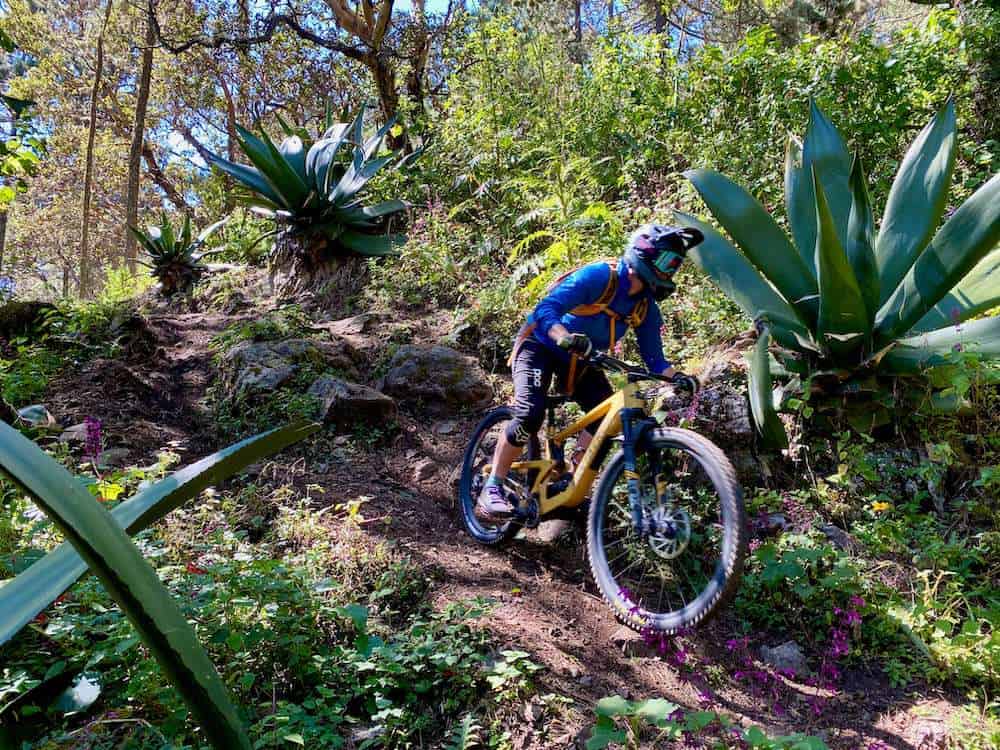
Waterproof rain jacket
Need to get a ride in, but the weather isn’t on your side? Stay dry with a waterproof mountain bike-specific jacket like the Revel Rider Reign Jacket.
Made from fully waterproof nylon and designed to be lightweight and breathable, you won’t even know that you have it on other than the fact that you’re staying dry.
It also has an adjustable hood that fits over your helmet if the deluge really starts coming.
Read next: Planning on riding in cold or wet weather? Check out my guide on Cold Weather Mountain Bike Gear
Final thoughts
Choosing the right attire for mountain biking is crucial to ensure a comfortable and safe experience on the trails.
Remember to prioritize functionality and protection, opting for moisture-wicking and breathable fabrics that offer freedom of movement.
Don’t forget to wear a helmet, gloves, and sturdy shoes to give yourself the best chance against crashes. So, gear up, stay safe, and let the mountains become your playground!
Happy riding!
RELATED POSTS
Looking for more tips on mountain bike gear and accessories? Check out these related blog posts:
What questions do you have about what to wear mountain? What are your favorite jerseys, shorts, gloves, shoes, and gear? Leave a comment below!

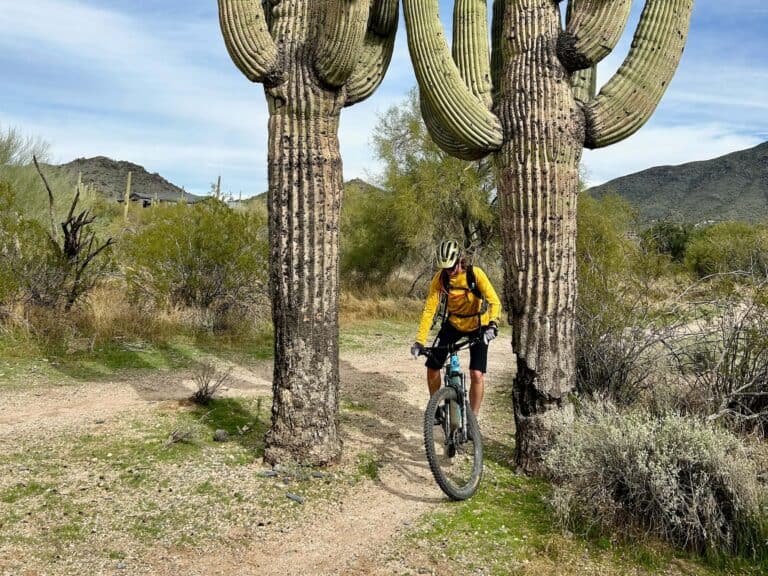
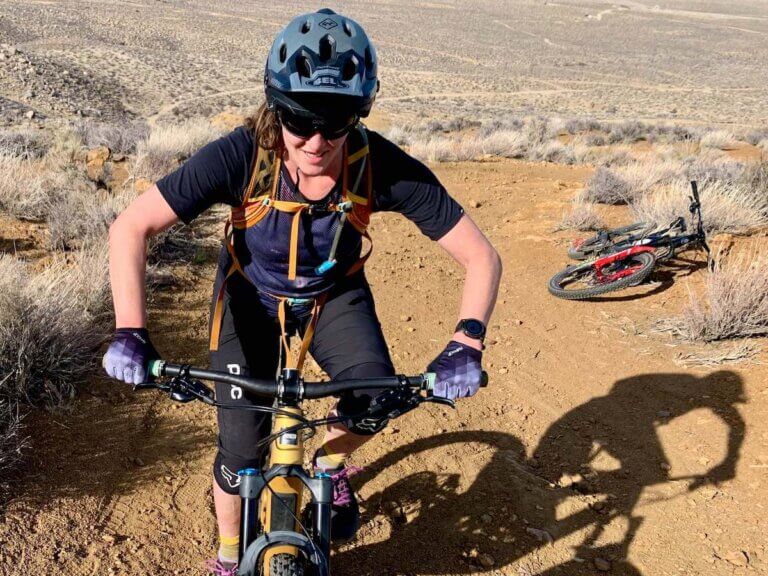
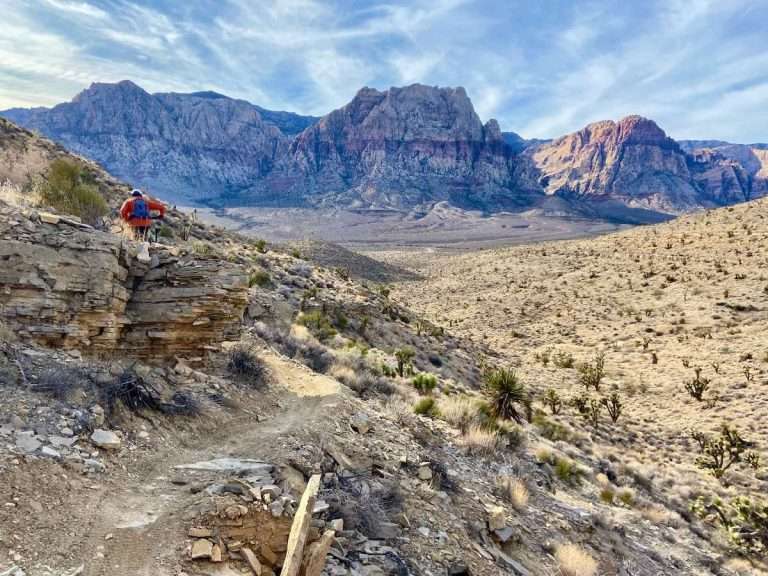
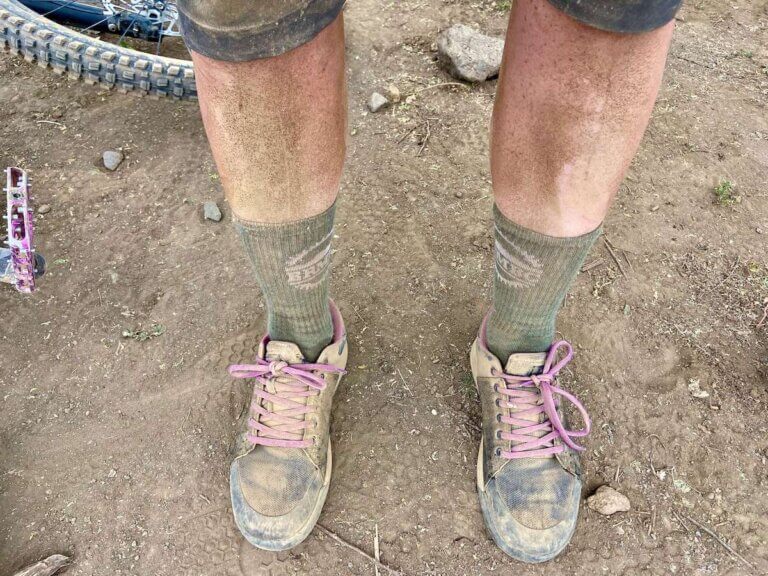
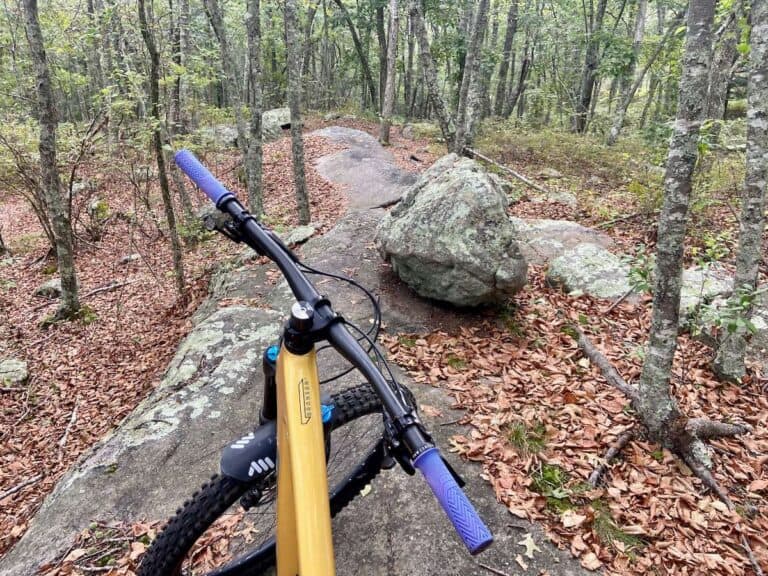
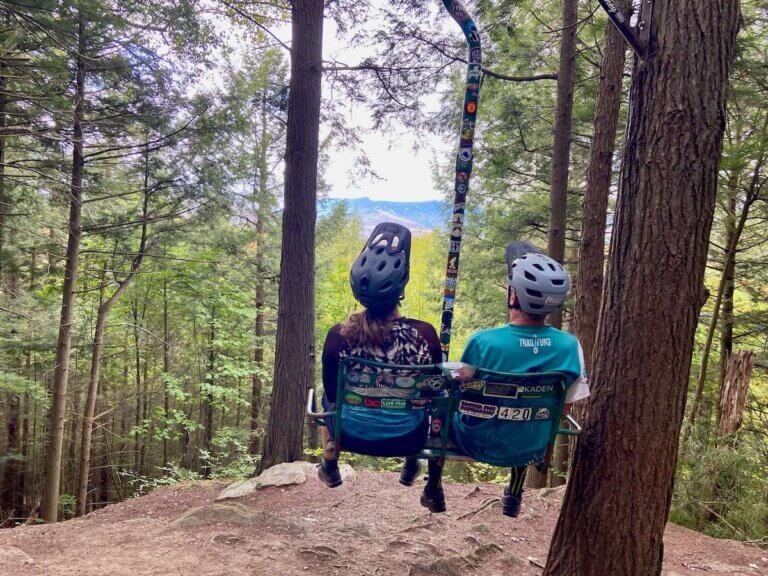
Dear I.W. (Iron Woman) otherwise known as Becky,
Lots of helpful ideas from one who knows and rides! (a lot).
Good luck/safe travel in Washington-beautiful country, fine people, and great
Alaskan seafood.
Thanks!
Bill DeForest The Woodlands Texas
Haha, thank you Bill – I appreciate the support and I\’ll definitely be enjoying some PNW seafood 🙂